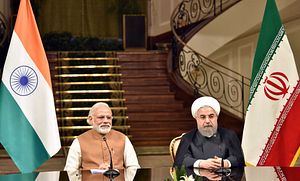Indian Prime Minister Narendra Modi’s visit to Iran this week comes at a time of dramatic transformation in Iran and its immediate region. Iran, now unencumbered by the burdens of stifling economic sanctions as a result of the P5+1 nuclear deal, is being reintegrated into the fold of global commerce. Iran’s “mainstreaming” coincides with increased competition for power and influence in the Middle East between Iran on the one hand, and Saudi Arabia and its allies on the other, the effects of which are being felt from Syria and Iraq in the north to Yemen in the south.
Iran’s eastern neighbor, Afghanistan, is also at an inflection point. News of the U.S. killing of the Taliban chief, Mullah Akhtar Mansour, was welcomed by Afghanistan’s leaders, but it may be too early to predict what Mansour’s death could mean for the insurgency or for the future of the war-torn country.
As for Modi’s visit, media attention in India has been largely focused on the Chabahar deal, first mooted by India and Iran in 2003 on the sidelines of the Non-Aligned Movement Summit in Tehran. Indeed, the presence of Modi, Iranian President Hassan Rouhani, and Afghan President Ashraf Ghani at the signing of the tripartite agreement is a testament to the significance being attached to the project. At the joint press conference in Tehran, Rouhani rightly observed that “the agreement today is not only an economic document; it is also a political and regional one too.”
The Chabahar deal has been 13 years in the making and came with its share of challenges. Although India attached great importance to Chabahar, U.S. and UN sanctions on Iran have inhibited meaningful progress on the deal thus far. Afghanistan and India have also complained that Iran was dragging its feet on Chabahar, while Indian officials suspected that Iran’s reluctance was linked to competing domestic political considerations and its challenges in the troubled Sistan and Baluchistan Province, where the country is battling an insurgency.
For energy-starved India, Chabahar will provide a vital link to the resource-rich Central Asian states and Afghanistan, where India has important commercial interests. For Afghanistan, Chabahar, together with the India-financed Zaranj-Delaram highway, will provide the landlocked country access to the Indian Ocean and allow it to trade with India by entirely bypassing Pakistan.
There were 12 other agreements of importance during Modi’s visit to Iran. These included the extension of a credit line by India for the development of infrastructure related to Chabahar, an agreement to establish a trade transport corridor, further Indian assistance in building rail infrastructure to improve Afghanistan’s connectivity via Iran, and a bilateral understanding to consult on combating terrorism, radicalism, drug trafficking, and cybercrime.
Taken as a whole, Modi’s visit to Iran was a success. However, the conclusion of the Chabahar agreement, as complex and arduous a negotiation process as it was, represents just the first step among many that India, Iran, and Afghanistan will need to undertake to reap its benefits.
Historically, India’s primary challenge in meeting foreign policy objectives has not been a dearth of ideas, but an inability to see commitments through. Delays on India’s part have left many partners exasperated. Iran’s Ambassador to India Gholamreza Ansari, for example, when counseled to have patience on India-Iran projects, retorted “Does India want to wait for centuries before capturing the right opportunities?”
India already faces myriad other challenges with regard to Chabahar, including its own limited resources and capacity to turn the port into a financially-viable competitor to Gwadar, which being developed by China in Pakistan’s restive Balochistan province. To counteract these challenges, WPS Sidhu, senior fellow at New York University’s Center on International Cooperation, rightly argues the project stands a far better chance at succeeding if India were able to co-opt other states like Japan and South Korea into investing in Chabahar than go at it alone.
More broadly, the challenge to Modi’s Middle East policy involves finding ways to significantly ramp up engagement with the region’s key actors – the energy-rich Gulf Arab states, Israel, and Iran – while continuing India’s policy of neutrality in relation to conflicts involving these often-sparring parties. India’s ability to balance these important actors in its extended neighborhood will likely be further tested as Saudi and Iranian ties come under further strain.
Since coming to office in 2014, Modi has concluded successful visits to the UAE, Saudi Arabia, and Iran and will travel to Qatar in early June. India’s continued engagement with the Gulf Arab states has yielded positive results. The UAE and Saudi Arabia are today India’s third and fourth largest trading partners. Improved counter-terrorism cooperation with these countries has allowed India to extradite terrorist operatives who have sought refuge in the Gulf.
The Modi government has rightly moved quickly to capitalize on the opportunities Iran’s mainstreaming provide. However, time will tell whether India and Iran can elevate their relationship to a more significant and mutually beneficial level, the routine declarations of “civilizational ties” notwithstanding.

































